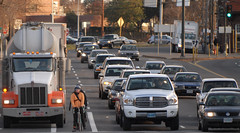Next week, Metro’s 17-member Joint Policy Advisory Committee on Transportation (JPACT) will vote on a policy direction that will guide them in handing out $20-24 million in federal transportation funds. With scarce transportation dollars at stake these days, freight and active transportation advocates are dueling to get their projects a larger piece of the pie.
This funding pot, known as “Regional Flexible Funds” have been extremely important for non-motorized transportation projects in recent years. Last year, Metro allocated a record amount of this money — around $10 million — to biking and walking projects while freight projects didn’t receive a dime. According to Gerik Kransky of the Bicycle Transportation Alliance, in the last two funding cycles, active transportation and complete streets projects have received an average of $19.9 million from this process.
“It’s unfortunate that these groups don’t seem to understand the value of active transportation in our community enough to support funding it at a higher level.”
— Gerik Kransky, BTA
Lake McTighe, project manager for Metro’s Active Transportation Partnership, says this money is “one of the main sources for bike and ped projects.” But, she adds, they are not specifically designated for any one type of project. “Each cycle, JPACT can look at the process of how those funds are allocated and they can change it.”
Leaders from public health, land use, environment, and biking and walking non-profit organizations wrote a letter to JPACT on June 9th urging them to maintain funding of active transportation projects current levels.
Last week, the BTA sent out an action alert to members because a coalition of freight and business interests have countered their efforts and hope to convince Metro to set aside a larger percentage of the money for freight projects. On June 8th, a letter signed by 15 people — including representatives from the Portland Business Alliance and Port of Portland as well as companies like Schnitzer Steel, Weyerhaeuser, Columbia Sportswear, and Fred Meyer — called on Metro to “strategically build the foundation for our green economy and recognize that freight mobility is an important part of that goal.”
Here’s another excerpt from the letter:
“Historical funding levels for freight projects… (approximately 1.8% of total funds per cycle) are not sufficient to address our region’s pressing need to create jobs and increase economic activity.”
One of the signatories of that letter, Port of Portland Executive Director Bill Wyatt, proposed a motion at JPACT’s June 17th meeting calling for a 75-25 split of the flexible funds. Wyatt wants Metro to direct 75% of available funds to “Green Economy/Freight Initiatives” (about $18 million) and 25% of the funds to “Active Transportation/Complete Streets” (about $6 million).

— but with an additional economic advantage.
The BTA’s Kransky says Metro is giving the proposal some serious consideration. Why? “The likely reason is political pressure.” On the BTA blog, he wrote, “It’s unfortunate that these groups don’t seem to understand the value of active transportation in our community enough to support funding it at a higher level.”
“JPACT started saying we’ll start applying a lot more to bike/ped… now it’s ballooned to a much larger percentage of funds… It’s sort of like going, ‘whoa what happened here?’.. Maybe we got slightly off track.”
— Corky Collier, Chair Portland Freight Committee
Kransky’s argument is that freight gets funding through a variety of other — and much larger — funding pots and that these regional flexible funds are a vital funding source for biking and walking projects, which currently get only 2% of the region’s total spending on transportation projects. “Regional Flexible Funds represent a small fraction of total regional transportation spending,” he writes, “but they are nearly one quarter of all regional bike and pedestrian spending.”
Corky Collier, Chair of the City of Portland’s Freight Committee, says if there are big pots of money for freight projects somewhere else, he’d love to find them. In response, he says, “Please point me to those pots… I just don’t know what they are. It’s easy to assume that the other group has all sorts of money.”
Collier says it’s the right time for JPACT to focus their funding allocation policy because the pendulum has swung too far in favor of biking and walking projects in recent years. The process in the past was “a little bit mushier” he says and it lacked the analysis to back up the increase in active transportation spending. “JPACT started saying we’ll start applying a lot more to bike/ped… now it’s ballooned to a much larger percentage of funds… It’s sort of like going, ‘whoa what happened here?’.. Maybe we got slightly off track.”
Collier says that since there are more active transportation projects in the works these days, “It behooves us to start thinking a little more carefully which the best projects are.” In a letter to the JPACT committee, Collier wrote,
“In the past, our investments in active transportation were not based on market studies, but rather in providing incremental connections to and from parks, transit, etc. As the region funds active transportation projects that cover more distance, we should increase the use of market studies and consider the practical limitations of active transportation.”
Also in his letter, Collier pointed out that only 4% of the trips in our region are made by foot or bike.
Even if the freight coalition doesn’t get the 75/25 split, Kransky says another proposal being floated by Metro Councilor Rex Burkholder is a 60/40 active transportation/freight split. That would also be a reduction and Kransky says “60/40 would be a cut and the BTA won’t support that.”
JPACT will meet again on July 8th where they’ll make a final decision on the parameters and policy direction of this funding allocation.


